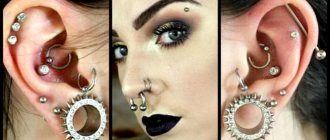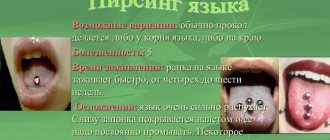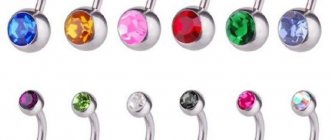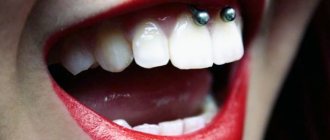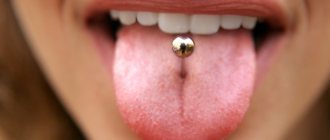Nowadays, more and more people are striving to break out of the gray mass, in any way to stand out from the crowd, so many teenagers (and adults too) resort to changes in appearance. They may not always be colossal, but nevertheless people change themselves day after day. One such way of self-expression is piercing. Piercing can also serve as a sign that you belong to a particular subculture, such as punks or rockers. Nowadays, various subcultures are becoming increasingly popular among young people.
The meaning of piercing
Piercing is a form of modification of any part of the body with soft skin tissue in order to insert jewelry there. Thus, the individual wants to emphasize her beauty and receive aesthetic pleasure. They use such decorations as labrets, rods, tunnels, studs and rings, but that’s not all! The most common facial piercings are eyebrow, lip, nose and tongue piercings. Piercings are also done on the navel and private parts of the body. The very concept of “piercing” can imply both the piercing process and the hole itself. Below are photos of tongue piercings and other types of punctures.
Do not play with or remove jewelry
Moving the jewelry can increase pain and irritation and lead to the appearance of new bacteria in the holes.
The only time you should touch it is during cleansing.
It may also be tempting to take out your jewelry, but this may actually do more harm than good.
Removing the jewelry will not only cause additional irritation, but will also allow the new piercing to be covered up. This can trap bacteria and allow the infection to spread beyond the puncture site.
The history of piercing
In ancient times, people from different tribes showed their class affiliation by piercing their ears, nose and other parts of the body, and it was believed that the more jewelry a person had on his body, the more authoritative the member of the tribe. Among the ancient Indians, a large number of punctures on the face was considered a symbol of courage, and ancient Roman warriors preferred to pierce their nipples - this meant courage and masculinity.
As for tongue piercing specifically, the story with it is much more interesting. The ancient Aztecs in the Mayan tribes of Central America pierced their tongues in order to release blood and appease the gods, thus making a kind of sacrifice. After the tongue was pierced, the blood was burned. It was believed that this ritual connected a person with God. A similar custom also existed among the Australian Aborigines, but they did it to release evil magic.
Which metal jewelry should you prefer?
For the first time after surgery, it is recommended to wear simple jewelry that is not framed with stones or patterns. Select the following material:
- Hypoallergenic plastic.
- Can be replaced with Teflon.
- If gold, then only high standard - 585 or 700.
- You can use surgical implant metal, but then replace it with a more expensive material.
When the hole is completely healed, you can afford another decoration. For lips, try to give preference to hypoallergenic materials. They have high biocompatibility with human skin and tissues. Moreover, they do not irritate the mucous membrane. In addition to standard metals, these can be amber, wood, niobium and even ivory.
Despite the widespread use of surgical metal products, you should not wear them immediately after a piercing. Due to the high concentration of nickel, such earrings often cause complications and suppuration of wounds.
General Information About Tongue Piercings
Before you pierce your tongue, you must determine for yourself whether you need it and prepare yourself mentally. Weigh the pros and cons of tongue piercing below. Of course, you can remove it at any time, and specifically piercing your tongue will certainly not disfigure you in any way, but the point is careful care, and you should also consult a doctor and find out if you have any contraindications, for example, sugar diabetes or allergies to certain types of metals. The wound, that is, the hole in the tongue, heals much faster than other types of piercing, but it requires more attention, since if it becomes infected, you can face serious threats to your health. Its essence lies in the fact that the soft fibers of the tongue are pierced, followed by the insertion of a special decoration - a barbell.
Dissolve ice or apply a cold compress / Cold compress
Cold compresses reduce pain and swelling. Numbness may be preferable to warm compresses, especially if you are experiencing severe pain.
Ice
You can suck on ice cubes for a few minutes to relieve symptoms. Repeat as many times as you want for body and face.
Regular compress
If ice cubes are not your thing, you can use a bag of frozen vegetables or soft ice to find relief.
To use a cold compress:
- Wrap the compress in a thin or strong paper towel.
- Gently apply to affected area for up to five minutes at a time.
- Repeat twice a day.
- Apply a warm compress | Warm compress
A warm compress can also minimize overall swelling and irritation.
You may not want to use a warm compress if you are already experiencing uncomfortably warm temperatures at the piercing site. In this case, start with a cold compress and progress to a warm compress if necessary.
Regular compress
You can make your own warm compress by placing a damp towel or other cloth-based item in the microwave for 30 seconds at a time.
Some store-bought compresses contain herbs or grains of rice, which help retain heat and apply gentle pressure. Beauty salon tattoo body and face enlarge individual parts.
You can make these changes to your homemade compress as well. Just make sure the fabric can be sealed or folded so that none of the added ingredients fall out.
To use a warm compress:
- Place a damp cloth, sock, or other homemade compress in the microwave for 30 seconds. Repeat until it is comfortably warm to the touch.
- If you have a heat compress, microwave or over-the-counter heat as directed on the product package.
- Apply the compress to the affected area (tattoo) for up to 10 minutes, up to two times a day.
Chamomile compress
Chamomile as a source has antioxidant and anti-inflammatory properties. A warm chamomile compress can speed up the healing process.
First, do a patch test to make sure you are not allergic to chamomile. Do it:
- Steep a chamomile tea bag in warm water for two to three minutes.
- Place the tea bag on the inside of your elbow.
- Leave on for three minutes and then remove. Let skin dry without rinsing.
- Wait 24 hours. If you do not experience redness or other signs of irritation, it is safe to apply a chamomile compress to the piercing.
To use a chamomile compress:
- Immerse two chamomile tea bags in boiled water for five minutes.
- Remove the tea bags and let them cool for about 30 seconds. The bags should be warm to the touch.
- Wrap each tea bag in a cloth or paper towel. This will help prevent the fibers from getting caught on your jewelry.
- Place a tea bag on each side of the hole for 10 minutes.
- Refresh tea bags with warm water if necessary.
- After 10 minutes, rinse the affected area with warm water and pat dry gently with a clean paper towel.
- Repeat this process daily.
- Avoid over-the-counter antibiotics and creams.
Over-the-counter antibiotics have long been used to treat infections. However, they are useless - and may even be dangerous - for body and facial piercings at a beauty salon.
Topical creams and ointments can trap bacteria inside the piercing and make the situation worse. Additionally, they are not intended for use in the mouth.
Oral cleansers containing hydrogen peroxide, alcohol and other antibacterial ingredients. They can also damage healthy skin cells and slow down the healing process.
You'd better stick to the cleansing and compress routine. Contact your piercer if you don't notice improvement within a day or two. Tongue piercing beauty salon tattoos to enlarge individual parts of the body and face.
Pros of piercing
- Through piercing a person liberates himself and tries something new in life.
- A girl's tongue piercing looks very sexy and also gives new sensations during kissing.
- During healing, you will need to adhere to a strict diet, with which you can even lose a couple of extra pounds.
- Low pain due to the needle passing between the muscle fibers.
- There is very little chance of getting an infection due to the antimicrobial properties of saliva.
You can find and identify for yourself several more advantages of tongue piercing, which consist, for example, in the beauty of this procedure.
Now let's move on to the disadvantages, which are also important and even necessary to familiarize yourself with before getting a piercing.
Risks
In general, tongue piercing is a fairly safe procedure. The biggest risk it poses is infection of the wound soon after the healing process begins. However, most infections are mild and can be easily treated with oral antibiotics.
However, sometimes people develop severe infections, such as abscesses. In such situations, the person may require hospitalization or intravenous antibiotics.
In addition, piercing is associated with the following risks:
- damage to teeth and gums;
- gum recession on the inside of the mouth;
- Ludwig's tonsillitis is a rare type of skin infection that develops under the tongue.
- Accidental ingestion of jewelry, which may result in choking or throat damage;
- acquiring diseases such as tetanus or HIV if the piercer uses unsterile instruments or jewelry that has already been used before.
- spread of infection to the blood or other organs (rarely observed).
In some cases, the body rejects the piercing, which can lead to further complications.
Cons of piercing
- Swelling and discomfort during healing.
- A metal barbell or other decoration can damage your mouth or teeth.
- Getting an infection can lead to a number of dangerous complications.
- There may be a violation of taste analyzers and/or diction.
- If you want the procedure to be performed efficiently, you will have to pay quite a lot for it. It is better to choose a more qualified surgeon than to have it done in an unknown place or with someone unknown.
The above contains equal parts of both pros and cons, so that you do not depend on this article and think for yourself, adding a few more points of your own. It is absolutely necessary to read tongue piercing reviews before the procedure.
If you have already had your tongue pierced, then the surgeon who pierced your tongue most likely told you how to properly care for it so as not to infect the wound. But for those who don’t know or for those who have pierced their tongue at home, below are instructions for caring for a tongue piercing.
Contraindications to the procedure
This procedure is contraindicated:
- persons under the age of majority, without the consent of guardians or parents;
- patients with diabetes and/or hemophilia;
- patients who are at the stage of exacerbation of chronic diseases;
- in case of blood clotting disorders;
- in the presence of infections in the oral cavity;
- in the absence of conditions for maintaining oral hygiene;
- for diseases of the autoimmune system;
- for mental and neurological disorders, epilepsy;
- in case of an allergic reaction to the decoration material;
- in case of an allergic reaction to antibiotics and anesthetics (in case of complications);
- with a cold and/or fever;
- persons under the influence of alcohol or drugs;
- pregnant women (high risk of infection).
A temporary violation of diction can negatively affect the professional activities of some clients (speakers, announcers, presenters and others).
Proper care
Care involves mandatory treatment of the oral cavity with an antiseptic, for example, a solution of potassium permanganate or soda. During the first few weeks, approximately the first two weeks, rinse your mouth with this solution after every meal and generally as often as possible. If you think that the tongue has begun to more or less heal, you should change the antiseptic to a softer one so as not to destroy the beneficial properties of saliva and not to injure the oral cavity. A milder remedy could be, for example, a decoction of some herbs, at best chamomile. At first, avoid spicy and hot foods; they can promote inflammation and the formation of ulcers and bleeding from the wound.
The bar, of course, also requires careful care. At first, brush it with a soft toothbrush, and later you will have to remove it regularly and disinfect it. This will need to be done even with complete healing.
Keep the rest of your mouth clean
When it comes to tongue piercings, you need to do more than just clean the piercing. You should also keep the rest of your mouth clean.
This will help prevent bacteria from spreading from your mouth and getting inside your piercing.
Dental floss
Flossing helps remove food debris and plaque stuck between your teeth. If not removed, it can lead to bacterial overgrowth and gingivitis. Floss your teeth once a day.
Cleaning
Brushing your teeth twice a day is just as important as flossing. You can also brush your teeth at midday to prevent bacteria buildup. Toothpaste is unlikely to harm your tongue piercing, but be sure to wash it thoroughly.
Rinsing
If you haven't used mouthwash before, there's no need to start now.
If you are using mouthwash as usual, follow the directions for use. Avoid alcohol-based rinses.
Tongue piercing process
If you turn to a competent specialist, he will do everything efficiently, painlessly and in the best possible way. Then everything will depend on you. But the process of piercing the tongue itself will be described below. If you are hesitant and don’t know whether to get your tongue pierced, or are afraid of pain, then read the step-by-step description of the piercing, and perhaps you will calm down.
So, the sequence of actions:
- The surgeon pre-processes all the instruments that will be needed.
- The master puts on gloves, which he also disinfects.
- The oral cavity should be thoroughly rinsed with an antiseptic solution, and the tongue should be separately disinfected with an antiseptic gel.
- The master makes the necessary marks with a marker.
- A puncture is made with a sterile clean needle and the earring is inserted.
- The oral cavity is again disinfected with an antiseptic solution.
Tongue piercing at home
If you decide to do a tongue piercing yourself, at home, which is extremely undesirable, then it is done as follows.
- Buy a disposable catheter and antiseptic at the pharmacy.
- Rinse your mouth with a disinfectant solution.
- Also treat the earring with alcohol.
- Lift your tongue with your fingers and make a mark between the two arteries. The mark should be exactly in the middle, this is very important!
- It's quite difficult to inflict pain on yourself, but next you will need to hold your tongue firmly and pierce it from the bottom up with a needle.
- While the needle is in the tongue, insert the jewelry without removing it.
- Rinse your mouth thoroughly with disinfectant.
Those people who have already tried to do this on their own will tell you that it is better to go to specialists. Despite the fact that the procedure seems extremely simple, it is not worth doing at home. Even an experienced doctor can sometimes damage your nerve or hit vital arteries, and it’s scary to think what you can do to yourself. Therefore, the opinion of surgeons regarding independent manipulation is sharply negative.
Touching on this topic, it is worth talking about the possible consequences of tongue piercing.
Choosing jewelry for girls (women), men
Before the procedure, the piercer will help you choose jewelry if the client has not purchased it in advance. If you want to buy it yourself, then a few tips below will help you make the right choice.
It is worth noting that there is no clear division between women's and men's jewelry. But unwritten rules still exist:
Consequences
If you went to an experienced doctor, then with proper treatment and care there will, of course, be no serious consequences. But an unsuccessful piercing may be accompanied by heavy bleeding if an artery is damaged or an unnatural color of the tongue. Improper puncture is harmful to your health, so in such a situation you should consult a surgeon.
Possible consequences of tongue piercing:
- Purulent discharge.
- Discomfort, burning sensation and almost unbearable pain.
- Unpleasant smell.
- A piece of jewelry that doesn't suit you can grow into your tongue, which will interfere with normal conversation.
- Paralysis of some muscles of the oral cavity, including the tongue.
- Violation of tooth enamel and gums, teeth become more brittle and weaker.
Quite unpleasant consequences, right? Be careful about yourself and your choice of piercer to prevent this from happening.
